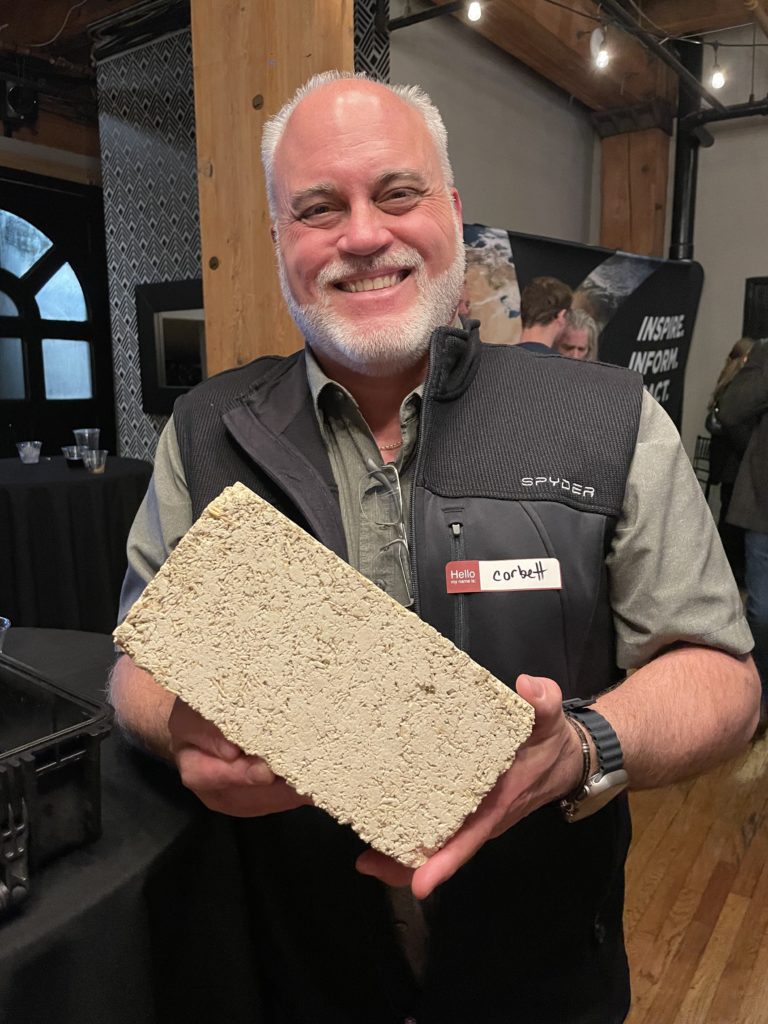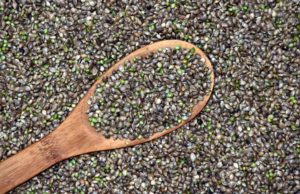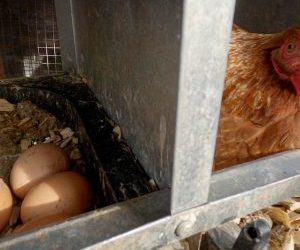

By Jean Lotus
A structural engineering study is in a third round of testing by a professor at the University of Nebraska-Lincoln to develop a hemp-based load-bearing masonry block. The new product has the potential to “greenify” the construction industry while also promoting a new agricultural crop for US farmers.
Marc Maguire, an assistant professor of civil engineering at U Nebraska-Lincoln’s Durham School of Architectural Engineering & Construction, has completed work on a prototype block, which will be manufactured by a local cement company in a trial run to undergo testing at the university before commercial manufacturing.
Subscribe for HempBuild Magazine’s free newsletter
Funding Maguire is Nebraska-based hemp processing company Global Fiber Processing, which is sponsoring the research along with the Nebraska Department of Economic Development. The private-public project plans to commercially license the blocks to concrete block manufacturers, utilizing US-grown industrial hemp.
The finished block will be the equivalent of a concrete masonry unit (CMU), commonly known as a cinder block, Maguire told HempBuild Mag.
The current laboratory version of the block meets strength, density, and water absorption criteria for standard CMUs required by ASTM C90. The strength of the developed material is 2500 psi, while coming in at half the weight of normal weight concrete (150 pcf vs 75 pcf). The team also subjected the laboratory specimens to simulated fire conditions and outperformed a portland cement control mixture. The material was shown to absorb considerable additional atmospheric carbon over its lifetime, gaining additional strength.
“Ultimately we’re making something that you’ll be able to buy on a pallet at Lowe’s,” he said. “Our goal is to make this a one-to-one swap. If an architect or engineer wants to build with concrete masonry units and wants a greener solution that has less of an impact on the environment, he or she can take our block and not even have to think about the engineering.”
Click here to join our Online Community.
The blocks are made from “hurd” or “shives” derived from the woody core of processed industrial hemp stalks mixed with a cementitious proprietary binder. The block is more than 50% hemp, developers told HempBuild Mag and weighs about half of a traditional cinder block.
Builders in Europe have been using hemp hurd with lime for a natural wall infill insulation product for 30 years. The new hemp CMU products are not being developed for insulation value but for load-bearing properties, Maguire said.
Unfortunately, the decades-old nickname “hempcrete” for the insulation is a misnomer, since the material hardens into a fibrous limestone, but is not load-bearing.
No hemp-based load-bearing substance has been sold yet as a commodity building material. Some in the developing hemp building industry consider a load-bearing product to be a “holy grail.”
Maguire rejected that characterization. “I don’t know if ‘holy grail’ is the right way to talk about it,” he said. “As an academic, I try not to use too grandiose of language. When you talk about anything in the realm of [construction] sustainability, you talk about a suite of solutions,” he said. He called the hemp-based cinder block “one piece of the puzzle.”
The revenue for the US concrete pipe and block manufacturing industry is projected to be $7.8bn in 2023, according to Ibisworld industry reports.
“We’re not really supplanting concrete with this. We’re taking a portion of the market that wants a sustainable solution,” Maguire said.
A local concrete block manufacturer will produce a trial run of around 500 blocks for research and development, and then the blocks will be tested for ASTM standards for compression strength and durability at the U Nebraska labs.
“The building and engineering industry is very conservative. Our number one goal is safety, right? We don’t want structures to fall down, and we don’t care about anything else. We don’t care what the structure looks like. We don’t really care about thermal performance. We want people to be safe,” Maguire said.
Graduate construction engineering and management Ph.D. student Zina Ebrahim is building computer models to determine the structural tests needed for the blocks. She said the project to create sustainable building materials attracted her to guide her future career path.
“I actually got excited because when you start reading about hemp, you’ll feel amazed because it has different properties that can improve the construction materials and can make an impact in the construction industry,” she told HempBuild Mag.
Ultimately, the plan is for the formula for the blocks to be licensed to localized concrete manufacturers across the United States and internationally. Concrete is usually regionally manufactured because of the shipping costs of moving cinder blocks.
The price of the blocks will be “competitive” with concrete cinder blocks, the team said.
Concrete is becoming more expensive because of the worldwide shortage of Portland cement, an ingredient in traditional concrete CMU blocks. To make Portland cement, limestone is extracted from quarries and burned at high temperatures, releasing large amounts of carbon dioxide. As much as 8% of the world’s human-derived greenhouse gasses come from the production of concrete.
As prices for Portland cement rise, at the same time, the price of industrial hemp agricultural products is expected to drop as the supply chain develops in the United States.
“We’re looking forward to trying to find a product that will be beneficial to the farmers in Nebraska,” said Alliance, NE farm owner Jeff Manion, part-owner of Global Fiber Processing. The company partners with two farm machinery companies, Colorado’s Formation Ag and Giltner, NE-based Bish Enterprises/Hemp Harvest Works.
Last year, in 2022, only 250 acres of industrial hemp was grown and harvested in Nebraska, according to the US Department of Agriculture’s National Agricultural Statistics Service.
“With this structural block, the volume of hemp crop grown that would get a small segment, maybe 1% of the block market, is a substantial amount of acres,” said Corbett Hefner of Formation Ag. That acreage could compete for farm acreage with traditional crops such as corn and soy and make farming hemp as a rotational crop financially attractive for farmers, Hefner said.
Creating a marketplace for hemp leads to a more vibrant farming economy overall, said Andrew Bish, co-owner of Bish Enterprises and founding partner of Global Fiber Processing. “Opening a marketplace to me is more than just figuring out how can we grow more hemp,” Bish told HempBuild Mag. “We need to have offload opportunities that allow enough acres of hemp to be grown so that hemp becomes a viable rotational crop.” Bish said other Nebraska faculty members such as NU-Lincoln’s plant-breeding and geneticist Ismail Dweikat have been working on a market pathway for hemp, even in the years before the 2018 Farm Bill legalized industrial hemp in the United States. “We’re blessed that we have some smart people in Nebraska,” Bish observed. The path to commodity crop for hemp can provide a missing rotational crop.
“Most of middle America is corn and soybeans, and there’s not a lot of alternatives,” Bish pointed out. “Then when you get into Kansas, you start working with the sorghum and cotton and there are not a lot of alternatives,” he said. Hemp as a commodity rotation crop will “improve the general soil quality so that we’re not competing directly with any other commodities, but we’re helping to reinforce those other commodities by providing a better rotation,” Bish said.
Meanwhile, in the green building industry, seeking to reduce the waste and pollution from the construction industry, many companies looking to hemp for innovation in construction materials. Builders are “looking for prefabrication instead of onsite mixing,” Ray Kaderli, president of the US Hemp Building Association told HempBuild Mag in an email. “A load-bearing block would be an important stride in the right direction,” he added.

Please Support Our Classified Advertisers
(To find out more about advertising CLICK HERE).
Help Wanted:
Publications
- Hemp Building Directory 2023 – Guide to the International Hemp Building Industry
- Available Now! “Hemp Buildings – 50 International Case Studies” by Steve Allin
Hemp Building Research and Training
Hemp Hurd (shivs)/Hemp Fiber/ Hemp Microfiber
- Hemp Building Company: Hempcrete Supplies, Training Programs. Longmont, CO
- Global Fiber Processing: Made From American Hemp
- South Bend Industrial Hemp: 100% American Hemp for Building
- PROducing Sustainable Fibers for Environmentally Conscious Consumers – Prairie PROducers
- Midwest Natural Fiber: US Grown Hemp
- HEMPALTA – Canada: Hemp to better serve the planet.
Hempcrete installers/Insulation subcontractors
- Americhanvre Cast Hemp: Supplies, Equipment, Experienced Hempcrete Installation
- Stuc-Go-Crete: Hempcrete and Stucco for the Heartland
- Hemp Build Network: We Make Building with Hemp Possible
- Hempknowlogy: Home of the Hempjet: America’s first hempcrete spraying system. Manchaca, TX
- Haven Earth PMA Hemp Consultancy
- Design and build your Hempcrete home with HempStone LLC complete consultants
Lime Binder
- Graymont Lime for Your Natural Building Needs
- US Heritage Group: Experienced Hemp Building Binder Suppliers
- Hemp Eco System Materials Now Available in the USA
Hemp Batt Insulation/Supplies
Hemp Wall Panel Products
- Preorder your hempcrete tiny house from Sativa Building Systems
- Panel solutions from Homeland Hempcrete
Hemp Blocks
Professional Associations
Events
- Carbon Zero Building with Hemp Materials SXSW, Austin TX March 11, 2022
- NoCo Hemp Expo Colorado Springs March 29-31, 2023



